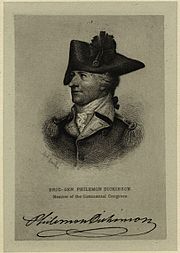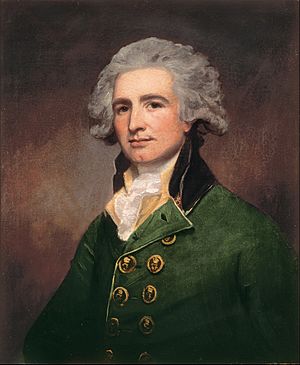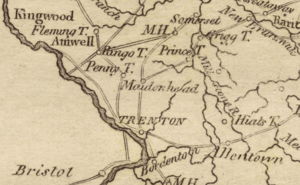Battle of Millstone facts for kids
Quick facts for kids Battle of Millstone |
|||||||
|---|---|---|---|---|---|---|---|
| Part of the American Revolutionary War | |||||||
 Brigadier General Philemon Dickinson |
|||||||
|
|||||||
| Belligerents | |||||||
| Commanders and leaders | |||||||
| Philemon Dickinson | Robert Abercromby | ||||||
| Strength | |||||||
| 450 | 500 | ||||||
| Casualties and losses | |||||||
| 4-5 killed or wounded | 25 killed or wounded 12 captured |
||||||
The Battle of Millstone, also known as the Battle of Van Nest's Mill, was a small fight during the American Revolutionary War. It happened on January 20, 1777, near a mill owned by Abraham Van Nest in Weston, New Jersey (which is now close to Manville, New Jersey).
During this battle, a group of British soldiers was looking for supplies. They were surprised and attacked by American forces, mostly made up of local New Jersey militia (citizen soldiers). The Americans successfully drove the British away, taking their wagons and supplies. This event was part of a larger series of small battles called the Forage War. It showed that even militia groups could fight well against the British army.
Contents
Why Did the Battle of Millstone Happen?
After George Washington's army won the Battle of Princeton on January 3, 1777, he had a problem. He was stuck between two British armies. One was led by General Cornwallis in Trenton, New Jersey. The other part of the British Army was in New Brunswick, New Jersey.
Washington decided not to attack New Brunswick because his soldiers were very tired. Instead, he moved his army to Morristown, New Jersey. This place was easy to defend and good for winter camp. General Cornwallis and the other British and Hessian (German) soldiers went back to New Brunswick to get organized after their loss at Princeton.
The British Search for Supplies
On January 13, a large group of British soldiers moved from New Brunswick to Somerset Court House (now Millstone, New Jersey). They stayed there for about a week. During this time, they destroyed homes and took supplies. Many local militia groups gathered to help the Continental Army.
After the British left, the area between New Brunswick and the Millstone River became a "no man's land." This meant neither side fully controlled it. Somerset Court House became a base for American Patriot militia groups, with some help from the Continental Army.
What Happened During the Battle?
On January 20, 1777, about 500 British soldiers left New Brunswick. They were led by Lieutenant Colonel Robert Abercromby. Their goal was to find food and supplies. They headed west towards the Millstone River.
The British crossed the river and left some Hessian soldiers with cannons to guard the bridge. They continued to Van Nest's mill in Weston, New Jersey. This mill was a few miles north of Somerset Court House. At the mill, they took many different kinds of supplies. Then, they got ready to go back to New Brunswick.
Militia Responds to the British Attack
American militia groups to the north quickly learned about the British movements. About 400 New Jersey militia and 50 Pennsylvania militia gathered. They were led by Brigadier General Philemon Dickinson. Their plan was to stop the British.
General Dickinson divided his forces. One group went to meet the front of the British wagons. Another group moved to attack them from the side. Both groups had to cross one of the rivers. They waded through icy water that was waist-deep.
One American group successfully surprised the British wagons near the mill. They fired at the horses pulling the first wagon. This stopped the entire line of wagons. The British wagon drivers ran away, and the British soldiers quickly retreated towards the bridge. They left all their stolen supplies behind.
When the American militia reached the bridge, the Hessian soldiers fired their cannons. They used "grape shot," which is like a lot of small cannonballs. This was to cover the British retreat. After some firing back and forth across the river, the British finally left.
What Was the Result of the Battle?

General Dickinson was very proud of his soldiers. He wrote a letter on January 23, saying that his 450 militia men attacked 500 British soldiers. He said they fought for 20 minutes and won. They captured 107 horses, 49 wagons, 115 cattle, 70 sheep, 40 barrels of flour, and 49 prisoners.
Even General Washington, who sometimes doubted the militia, praised Dickinson. He wrote that Dickinson's actions were "the highest honour upon him." Washington noted that Dickinson led his new troops through the river and attacked the enemy so hard that they ran away. Washington reported that nine prisoners were taken.
A British officer named Archibald Robertson also wrote about the battle. He said that Lieutenant Colonel Abercromby's group was attacked. This caused such a mess among the wagon drivers that 42 wagons were left behind. One British witness was very surprised by how well the Americans fought. They said they were sure the attackers were not just militia because they fought so bravely.
The number of soldiers hurt or captured varied in different reports. British losses (killed, wounded, or captured) were likely around 30. The American militia had very few losses, only about 4 or 5.
The Forage War Continues
Small fights between American and British forces continued throughout the winter. This period is known as the Forage War. It was called this because the British desperately needed "forage" (food) for their horses. The American tactics, mostly led by New Jersey militia, were very successful. They even attacked large British groups of 2,000 men, like at the Battle of Quibbletown on February 8.
Images for kids




